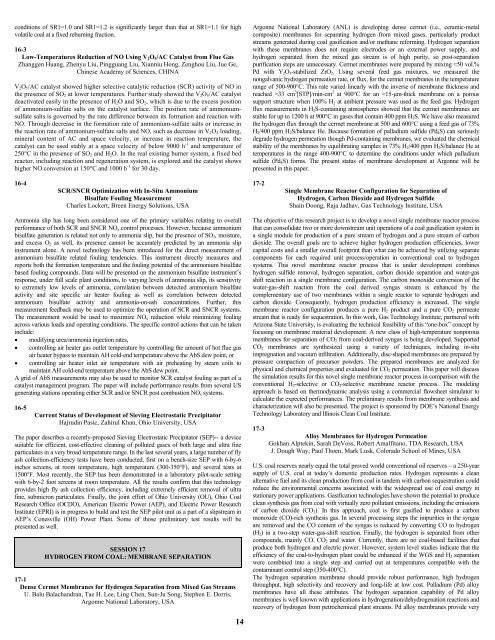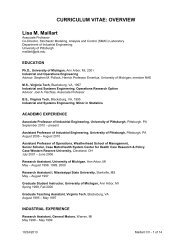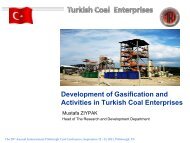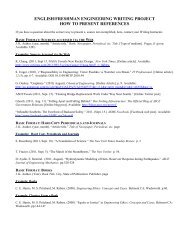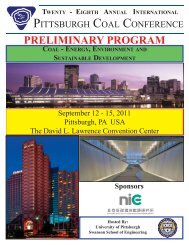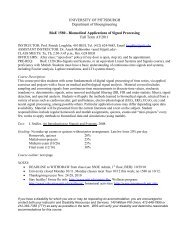Abstract Booklet 2006 - Swanson School of Engineering - University ...
Abstract Booklet 2006 - Swanson School of Engineering - University ...
Abstract Booklet 2006 - Swanson School of Engineering - University ...
You also want an ePaper? Increase the reach of your titles
YUMPU automatically turns print PDFs into web optimized ePapers that Google loves.
conditions <strong>of</strong> SR1=1.0 and SR1=1.2 is significantly larger than that at SR1=1.1 for high<br />
volatile coal at a fixed reburning fraction.<br />
16-3<br />
Low-Temperatures Reduction <strong>of</strong> NO Using V 2 O 5 /AC Catalyst from Flue Gas<br />
Zhanggen Huang, Zhenyu Liu, Pingguang Liu, Xianniu Hong, Zenghou Liu, Jue Ge,<br />
Chinese Academy <strong>of</strong> Sciences, CHINA<br />
V 2 O 5 /AC catalyst showed higher selective catalytic reduction (SCR) activity <strong>of</strong> NO in<br />
the presence <strong>of</strong> SO 2 at lower temperatures. Further study showed the V 2 O 5 /AC catalyst<br />
deactivated easily in the presence <strong>of</strong> H 2 O and SO 2 , which is due to the excess position<br />
<strong>of</strong> ammonium-sulfate salts on the catalyst surface. The position rate <strong>of</strong> ammoniumsulfate<br />
salts is governed by the rate difference between its formation and reaction with<br />
NO. Through decrease in the formation rate <strong>of</strong> ammonium-sulfate salts or increase in<br />
the reaction rate <strong>of</strong> ammonium-sulfate salts and NO, such as decrease in V 2 O 5 loading,<br />
mineral content <strong>of</strong> AC and space velocity, or increase in reaction temperature, the<br />
catalyst can be used stably at a space velocity <strong>of</strong> below 9000 h -1 and temperature <strong>of</strong><br />
250°C in the presence <strong>of</strong> SO 2 and H 2 O. In the real existing burner system, a fixed bed<br />
reactor, including reaction and regeneration system, is explored and the catalyst shows<br />
higher NO conversion at 150°C and 1000 h -1 for 30 day.<br />
Argonne National Laboratory (ANL) is developing dense cermet (i.e., ceramic-metal<br />
composite) membranes for separating hydrogen from mixed gases, particularly product<br />
streams generated during coal gasification and/or methane reforming. Hydrogen separation<br />
with these membranes does not require electrodes or an external power supply, and<br />
hydrogen separated from the mixed gas stream is <strong>of</strong> high purity, so post-separation<br />
purification steps are unnecessary. Cermet membranes were prepared by mixing ≈50 vol.%<br />
Pd with Y 2 O 3 -stabilized ZrO 2 . Using several feed gas mixtures, we measured the<br />
nongalvanic hydrogen permeation rate, or flux, for the cermet membranes in the temperature<br />
range <strong>of</strong> 500-900°C. This rate varied linearly with the inverse <strong>of</strong> membrane thickness and<br />
reached ≈33 cm 3 [STP]/min-cm 2 at 900°C for an ≈15-μm-thick membrane on a porous<br />
support structure when 100% H 2 at ambient pressure was used as the feed gas. Hydrogen<br />
flux measurements in H 2 S-containing atmospheres showed that the cermet membranes are<br />
stable for up to 1200 h at 900°C in gases that contain 400 ppm H 2 S. We have also measured<br />
the hydrogen flux through the cermet membrane at 500 and 600°C using a feed gas <strong>of</strong> 73%<br />
H 2 /400 ppm H 2 S/balance He. Because formation <strong>of</strong> palladium sulfide (Pd 4 S) can seriously<br />
degrade hydrogen permeation though Pd-containing membranes, we evaluated the chemical<br />
stability <strong>of</strong> the membranes by equilibrating samples in 73% H 2 /400 ppm H 2 S/balance He at<br />
temperatures in the range 400-900°C to determine the conditions under which palladium<br />
sulfide (Pd 4 S) forms. The present status <strong>of</strong> membrane development at Argonne will be<br />
presented in this paper.<br />
16-4<br />
SCR/SNCR Optimization with In-Situ Ammonium<br />
Bisulfate Fouling Measurement<br />
Charles Lockert, Breen Energy Solutions, USA<br />
17-2<br />
Single Membrane Reactor Configuration for Separation <strong>of</strong><br />
Hydrogen, Carbon Dioxide and Hydrogen Sulfide<br />
Shain Doong, Raja Jadhav, Gas Technology Institute, USA<br />
Ammonia slip has long been considered one <strong>of</strong> the primary variables relating to overall<br />
performance <strong>of</strong> both SCR and SNCR NO x control processes. However, because ammonium<br />
bisulfate generation is related not only to ammonia slip, but the presence <strong>of</strong> SO 3 , moisture,<br />
and excess O 2 as well, its presence cannot be accurately predicted by an ammonia slip<br />
instrument alone. A novel technology has been introduced for the direct measurement <strong>of</strong><br />
ammonium bisulfate related fouling tendencies. This instrument directly measures and<br />
reports both the formation temperature and the fouling potential <strong>of</strong> the ammonium bisulfate<br />
based fouling compounds. Data will be presented on the ammonium bisulfate instrument’s<br />
response, under full scale plant conditions, to varying levels <strong>of</strong> ammonia slip, its sensitivity<br />
to extremely low levels <strong>of</strong> ammonia, correlation between detected ammonium bisulfate<br />
activity and site specific air heater fouling as well as correlation between detected<br />
ammonium bisulfate activity and ammonia-on-ash concentrations. Further, this<br />
measurement feedback may be used to optimize the operation <strong>of</strong> SCR and SNCR systems.<br />
The measurement would be used to maximize NO x reduction while minimizing fouling<br />
across various loads and operating conditions. The specific control actions that can be taken<br />
include:<br />
• modifying urea/ammonia injection rates,<br />
• controlling air heater gas outlet temperature by controlling the amount <strong>of</strong> hot flue gas<br />
air heater bypass to maintain AH cold-end temperature above the AbS dew point, or<br />
• controlling air heater inlet air temperature with air preheating by steam coils to<br />
maintain AH cold-end temperature above the AbS dew point.<br />
A grid <strong>of</strong> AbS measurements may also be used to monitor SCR catalyst fouling as part <strong>of</strong> a<br />
catalyst management program. The paper will include performance results from several US<br />
generating stations operating either SCR and/or SNCR post combustion NO x systems.<br />
16-5<br />
Current Status <strong>of</strong> Development <strong>of</strong> Sieving Electrostatic Precipitator<br />
Hajrudin Pasic, Zahirul Khan, Ohio <strong>University</strong>, USA<br />
The paper describes a recently-proposed Sieving Electrostatic Precipitator (SEP)-- a device<br />
suitable for efficient, cost-effective cleaning <strong>of</strong> polluted gases <strong>of</strong> both large and ultra fine<br />
particulates in a very broad temperature range. In the last several years, a large number <strong>of</strong> fly<br />
ash collection-efficiency tests have been conducted, first on a bench-size SEP with 6-by-6<br />
inches screens, at room temperature, high temperature (300-350°F), and several tests at<br />
1500°F. Most recently, the SEP has been demonstrated in a laboratory pilot-scale setting<br />
with 6-by-2 foot screens at room temperature. All the results confirm that this technology<br />
provides high fly ash collection efficiency, including extremely efficient removal <strong>of</strong> ultra<br />
fine, submicron particulates. Finally, the joint effort <strong>of</strong> Ohio <strong>University</strong> (OU), Ohio Coal<br />
Research Office (OCDO), American Electric Power (AEP), and Electric Power Research<br />
Institute (EPRI) is in progress to build and test the SEP pilot unit as a part <strong>of</strong> a slipstream in<br />
AEP’s Conesville (OH) Power Plant. Some <strong>of</strong> those preliminary test results will be<br />
presented as well.<br />
SESSION 17<br />
HYDROGEN FROM COAL: MEMBRANE SEPARATION<br />
17-1<br />
Dense Cermet Membranes for Hydrogen Separation from Mixed Gas Streams<br />
U. Balu Balachandran, Tae H. Lee, Ling Chen, Sun-Ju Song, Stephen E. Dorris,<br />
Argonne National Laboratory, USA<br />
The objective <strong>of</strong> this research project is to develop a novel single membrane reactor process<br />
that can consolidate two or more downstream unit operations <strong>of</strong> a coal gasification system in<br />
a single module for production <strong>of</strong> a pure stream <strong>of</strong> hydrogen and a pure stream <strong>of</strong> carbon<br />
dioxide. The overall goals are to achieve higher hydrogen production efficiencies, lower<br />
capital costs and a smaller overall footprint than what can be achieved by utilizing separate<br />
components for each required unit process/operation in conventional coal to hydrogen<br />
systems. This novel membrane reactor process that is under development combines<br />
hydrogen sulfide removal, hydrogen separation, carbon dioxide separation and water-gas<br />
shift reaction in a single membrane configuration. The carbon monoxide conversion <strong>of</strong> the<br />
water-gas-shift reaction from the coal derived syngas stream is enhanced by the<br />
complementary use <strong>of</strong> two membranes within a single reactor to separate hydrogen and<br />
carbon dioxide. Consequently, hydrogen production efficiency is increased. The single<br />
membrane reactor configuration produces a pure H 2 product and a pure CO 2 permeate<br />
stream that is ready for sequestration. In this work, Gas Technology Institute, partnered with<br />
Arizona State <strong>University</strong>, is evaluating the technical feasibility <strong>of</strong> this “one-box” concept by<br />
focusing on membrane material development. A new class <strong>of</strong> high-temperature nonporous<br />
membranes for separation <strong>of</strong> CO 2 from coal-derived syngas is being developed. Supported<br />
CO 2 membranes are synthesized using a variety <strong>of</strong> techniques, including in-situ<br />
impregnation and vacuum infiltration. Additionally, disc-shaped membranes are prepared by<br />
pressure compaction <strong>of</strong> precursor powders. The prepared membranes are analyzed for<br />
physical and chemical properties and evaluated for CO 2 permeation. This paper will discuss<br />
the simulation results for this novel single membrane reactor process in comparison with the<br />
conventional H 2 -selective or CO 2 -selective membrane reactor process. The modeling<br />
approach is based on thermodynamic analysis using a commercial flowsheet simulator to<br />
calculate the expected performances. The preliminary results from membrane synthesis and<br />
characterization will also be presented. The project is sponsored by DOE’s National Energy<br />
Technology Laboratory and Illinois Clean Coal Institute.<br />
17-3<br />
Alloy Membranes for Hydrogen Permeation<br />
Gokhan Alptekin, Sarah DeVoss, Robert Amalfitano, TDA Research, USA<br />
J. Dough Way, Paul Thoen, Mark Lusk, Colorado <strong>School</strong> <strong>of</strong> Mines, USA<br />
U.S. coal reserves nearly equal the total proved world conventional oil reserves – a 250-year<br />
supply <strong>of</strong> U.S. coal at today’s domestic production rates. Hydrogen represents a clean<br />
alternative fuel and its clean production from coal in tandem with carbon sequestration could<br />
reduce the environmental concerns associated with the widespread use <strong>of</strong> coal energy in<br />
stationary power applications. Gasification technologies have shown the potential to produce<br />
clean synthesis gas from coal with virtually zero pollutant emissions, including the emissions<br />
<strong>of</strong> carbon dioxide (CO 2 ). In this approach, coal is first gasified to produce a carbon<br />
monoxide (CO)-rich synthesis gas. In several processing steps the impurities in the syngas<br />
are removed and the CO content <strong>of</strong> the syngas is reduced by converting CO to hydrogen<br />
(H 2 ) in a two-step water-gas-shift reaction. Finally, the hydrogen is separated from other<br />
compounds, mainly CO, CO 2 and water. Currently, there are no coal-based facilities that<br />
produce both hydrogen and electric power. However, system level studies indicate that the<br />
efficiency <strong>of</strong> the coal-to-hydrogen plant could be enhanced if the WGS and H 2 separation<br />
were combined into a single step and carried out at temperatures compatible with the<br />
contaminant control step (350-400°C).<br />
The hydrogen separation membrane should provide robust performance, high hydrogen<br />
throughput, high selectivity and recovery and long-life at low cost. Palladium (Pd) alloy<br />
membranes have all these attributes. The hydrogen separation capability <strong>of</strong> Pd alloy<br />
membranes is well known with applications in hydrogenation/dehydrogenation reactions and<br />
recovery <strong>of</strong> hydrogen from petrochemical plant streams. Pd alloy membranes provide very<br />
14


